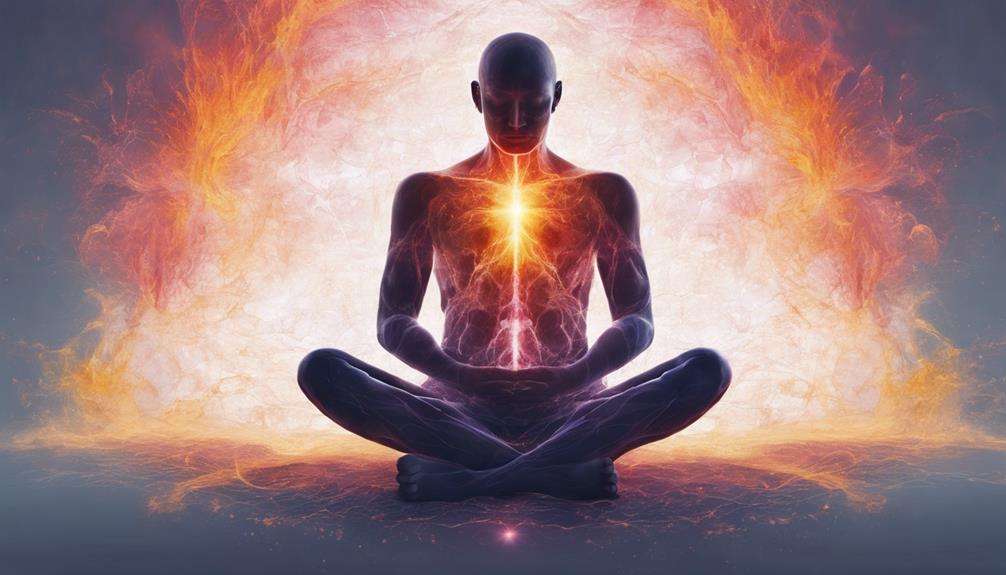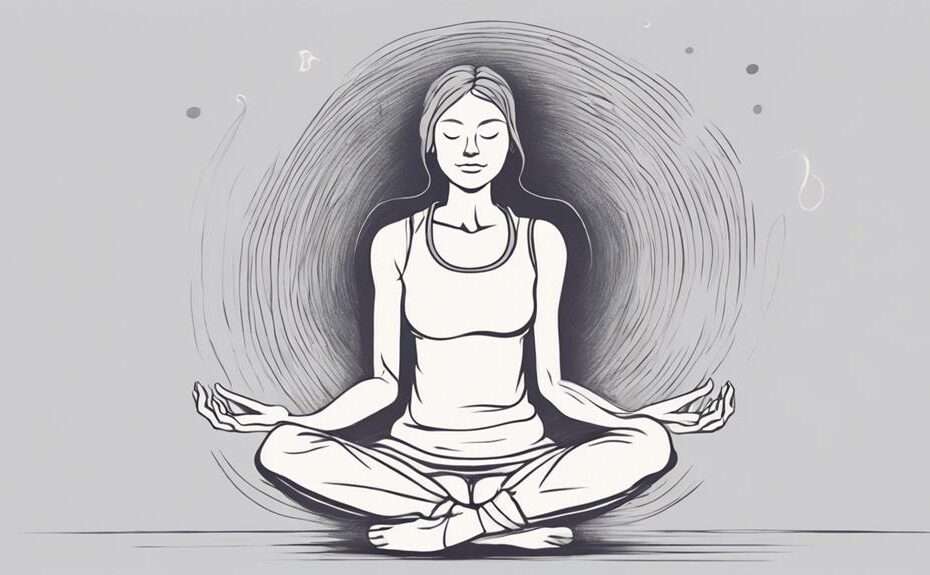Have you ever pondered why meditation could be a beneficial tool for easing muscle pain?
Imagine a practice that not only relaxes your muscles but also enhances blood flow and reduces stress levels.
The potential of meditation to address stress-induced muscle tension and alleviate pain is intriguing.
By fostering a calm mind and directing attention to the present, meditation might just hold the key to relieving muscle spasms, aches, and discomfort.
It's worth exploring how this ancient practice could offer a natural solution to your muscle-related woes.
Key Takeaways
- Meditation reduces muscle tension and pain intensity effectively.
- Enhances pain tolerance and triggers endorphin release for relief.
- Complements traditional pain management methods naturally.
- Promotes relaxation, reduces emotional distress, and aids overall well-being.
Benefits of Meditation for Muscle Pain
Meditation offers significant benefits for relieving muscle pain by promoting relaxation and reducing tension in the affected muscles. When you engage in meditation, you allow your muscles to relax, easing the tightness and discomfort commonly associated with muscle pain. Studies have shown that practicing meditation can lead to a reduction in the intensity of muscle pain by approximately 40%, providing a natural and effective method for pain relief.
By calming your mind and body through meditation, you can also increase your pain tolerance, making it easier to cope with discomfort. Furthermore, meditation triggers the release of endorphins, which are natural chemicals in the body known for their pain-relieving properties. Incorporating meditation into your routine can complement traditional pain management approaches, offering a holistic way to alleviate muscle pain.
Next time you experience muscle pain, consider turning to meditation as a valuable tool for promoting relief and enhancing your overall well-being.
Understanding Muscle Pain Mechanisms
Understanding the mechanisms behind muscle pain is essential for effectively managing and addressing the factors contributing to discomfort and impaired function. Muscle pain can stem from various sources like overuse, injury, tension, or medical conditions, impacting daily activities and overall quality of life. Here are some key points to consider in comprehending muscle pain mechanisms:
- Inflammation plays a crucial role in triggering and exacerbating muscle pain.
- Nerve sensitivity can heighten the perception of pain signals, amplifying the discomfort experienced.
- Muscle tension contributes to the development and persistence of muscle pain.
- Impaired blood flow to the muscles can result in inadequate oxygen and nutrient delivery, exacerbating pain.
- Chronic pain lasting more than three months often involves a complex interplay of factors like stress, poor posture, and muscle imbalances, requiring a comprehensive approach to management.
Mindfulness Meditation Techniques

Mindfulness meditation techniques, such as focusing on your breathing for relaxation and using the body scan method, can help you observe muscle pain sensations without immediate reactions. By practicing these techniques regularly, you can enhance your pain tolerance and reduce emotional distress associated with muscle pain.
Studies suggest that mindfulness meditation can lead to beneficial changes in brain function and structure for individuals dealing with muscle pain.
Breathing for Relaxation
Deep and deliberate breathing techniques can be a powerful tool for inducing relaxation and reducing muscle tension. When practicing mindfulness meditation, focusing on your breath can help alleviate muscle pain and promote a sense of calm. Here are some ways deep breathing can aid in relaxation:
- Enhances oxygen flow to muscles, aiding in relaxation and pain relief.
- Alleviates stress-related muscle tightness and discomfort.
- Improves muscle flexibility over time with consistent practice.
- Reduces pain sensitivity through relaxation induced by controlled breathing.
- Promotes a state of relaxation that can help combat muscle tension and pain.
Body Scan Technique
Utilizing the body scan technique in mindfulness meditation involves systematically scanning your body from head to toe to heighten awareness of physical sensations and alleviate muscle tension for relaxation and pain relief. This technique helps you identify areas of tightness or discomfort, enabling targeted relief and promoting overall relaxation.
By focusing on individual body parts, you can increase body awareness, which is beneficial for early detection and management of muscle pain. Research indicates that regular practice of the body scan technique can improve how you perceive pain, decrease stress levels, and contribute to your overall well-being, especially if you're experiencing muscle pain.
Incorporating the body scan into your mindfulness meditation routine may offer significant benefits in alleviating muscle pain and enhancing relaxation.
Breathing Exercises for Pain Relief
To alleviate muscle pain effectively, incorporating breathing exercises into your routine can be beneficial for promoting relaxation and reducing tension in your body. When you engage in breathing exercises, you're actively participating in your pain relief journey. Here are some benefits of incorporating breathing exercises for pain relief:
- Promotes Relaxation: Deep breathing techniques can help calm your mind and relax your muscles, reducing the overall sensation of pain.
- Enhances Oxygen Flow: By practicing controlled breathing, you increase the oxygen supply to your muscles, aiding in pain relief and faster muscle recovery.
- Reduces Stress Levels: Breathing exercises can lower stress levels, which are often linked to muscle pain and tension.
- Activates Relaxation Response: Diaphragmatic breathing triggers the body's relaxation response, alleviating muscle spasms and discomfort.
- Improves Pain Management: Regular practice of breathing exercises can enhance your overall pain management strategies and contribute to your well-being.
Incorporating these simple yet powerful techniques into your daily routine can make a significant difference in how you experience and manage muscle pain.
Visualization Practices for Muscle Pain

Visualization practices during meditation can significantly impact muscle pain perception and promote relaxation. By mentally picturing a peaceful setting or desired outcome, you can reduce the sensation of muscle pain. Engaging in guided imagery during meditation serves as a distraction from the sensations of pain, allowing for a more relaxed state.
Research indicates that visualization techniques have the ability to alter pain perception by influencing brain activity in regions responsible for processing pain. Through visualization practices in meditation, you can enhance the connection between your mind and body, potentially leading to reduced muscle tension and discomfort.
Body Scan Meditation for Pain Management
Body scan meditation is a technique that involves systematically focusing on different parts of your body to promote relaxation and alleviate pain. This practice can be particularly beneficial for managing muscle pain by increasing awareness of tension and discomfort in specific muscle areas. Here are some key points about body scan meditation for pain relief:
- Helps you develop mindfulness of your body's signals.
- Reduces muscle tension through focused attention.
- Promotes deep relaxation and stress reduction.
- Decreases perceived pain intensity.
- Improves overall well-being and coping mechanisms for muscle pain.
Research supports the effectiveness of body scan meditation in alleviating muscle pain and enhancing your ability to cope with discomfort. By incorporating this practice into your routine, you can cultivate a greater sense of relaxation, awareness, and resilience in the face of muscle pain.
Progressive Muscle Relaxation Techniques

Engage in progressive muscle relaxation techniques to effectively reduce tension and alleviate muscle pain. This method involves intentionally tensing and then releasing specific muscle groups throughout your body. By targeting individual muscles, you can increase your awareness of bodily sensations and promote overall relaxation.
Progressive muscle relaxation is known to enhance blood circulation, which can help reduce muscle stiffness and alleviate discomfort associated with muscle pain. Studies have indicated that regular practice of this technique leads to a decrease in the intensity of muscle pain and an overall improvement in well-being.
The simplicity and effectiveness of progressive muscle relaxation make it a valuable tool for managing muscle pain. By incorporating this practice into your daily routine, you can proactively address tension and discomfort, ultimately contributing to a healthier and more comfortable physical state.
Start exploring progressive muscle relaxation today to experience its benefits on your muscle pain and overall well-being.
Incorporating Meditation Into Daily Routine
To enhance your muscle health and alleviate discomfort, consider integrating daily meditation into your routine. Meditation helps manage stress, a common trigger for muscle pain, by promoting relaxation and improving pain tolerance. By incorporating meditation into your daily regimen, you can enhance blood circulation to your muscles, reducing spasms and aches.
Here are some practical tips to help you incorporate meditation into your daily routine:
- Start your day with a short meditation session to set a positive tone.
- Take short meditation breaks throughout the day to relieve stress and muscle tension.
- Use guided meditation apps or videos to assist you in your practice.
- Create a quiet and comfortable space dedicated to your meditation practice.
- Reflect on how meditation is benefiting your muscle health and overall well-being.
Frequently Asked Questions
Can Meditation Help With Muscle Pain?
Meditation can help with muscle pain by enhancing the mind-body connection, practicing relaxation techniques, managing pain effectively, and providing stress relief. It reduces pain intensity by about 40%, offering a holistic approach to pain relief.
What Are the Benefits of Meditation for Muscles?
When you meditate, your mind-body connection strengthens, reducing stress and promoting muscle relaxation. The healing energy from meditation increases blood flow, aiding in muscle recovery. Regular practice enhances overall muscle health by reducing tension and promoting renewal.
How to Heal Pain Through Meditation?
To heal pain through meditation, focus on the mind-body connection. Use relaxation techniques, mindfulness practice, and stress reduction strategies. These practices alter brain activity, increase pain tolerance, and release endorphins, aiding in pain relief.
How Does Meditation Increase Pain Tolerance?
Meditation enhances your mind-body connection, boosting pain tolerance. Through meditation techniques like deep breathing, you manage physical discomfort better, building mental resilience. This practice aids in acknowledging and accepting pain, ultimately promoting pain relief.
Conclusion
In conclusion, meditating to alleviate muscle pain is like a soothing balm for your body and mind. By practicing mindfulness and relaxation techniques, you can unlock the power of your own healing potential.
Remember, just as a gentle breeze can calm the stormy seas, meditation can ease the tension in your muscles and bring peace to your entire being. Embrace this holistic approach to pain management and watch your body and mind thrive.






